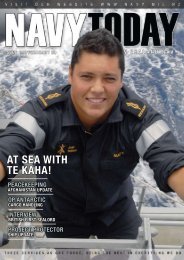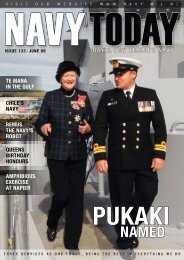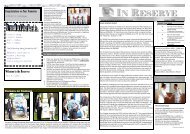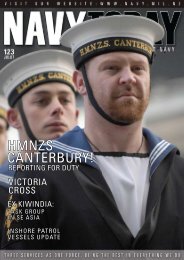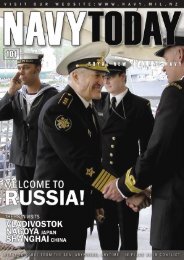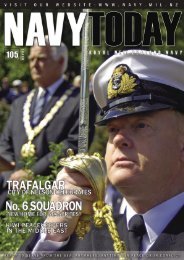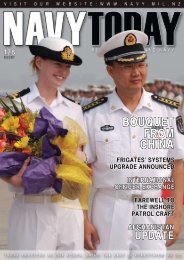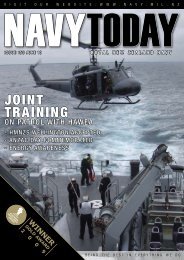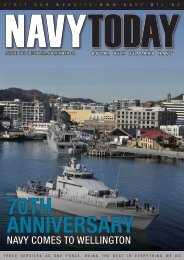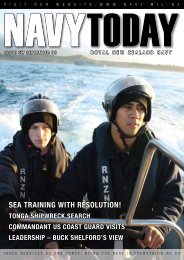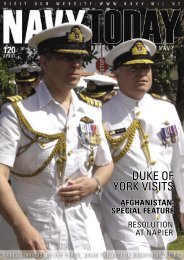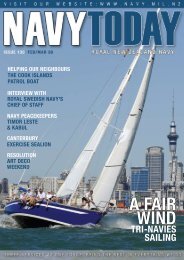Navy Today July 08 | Issue 134 - Royal New Zealand Navy
Navy Today July 08 | Issue 134 - Royal New Zealand Navy
Navy Today July 08 | Issue 134 - Royal New Zealand Navy
- No tags were found...
Create successful ePaper yourself
Turn your PDF publications into a flip-book with our unique Google optimized e-Paper software.
SPORT“ERNEST RUTHERFORDON THE ADMIRALTYBOARD OF INVENTIONAND RESEARCHDEVISED A VARIETYOF MICROPHONES,DIAPHRAGMS ANDUNDERWATER RECEIVERSFOR UNDERWATERSOUND”Hydrophones in use aboard a drifter– this appears to be a training event;6 officers and senior ratings arelistening on headphones, while therating at right prepares to lower ahydrophone into the water.valid). The heavy sinkings by the Flanders U-boat flotilla in the English Channel during thelast quarter of 1916 resulted in representationsby the French naval authorities to instituteescorted convoys of colliers to France. Theseconvoys commenced in January 1917 andsinkings dropped dramatically, with a loss rateof only 0.19% over the next three months.Following this success, trial ocean convoyscommenced in May 1917. Once again shiplosses were minimal compared to ships sailingindependently. Destroyers and other vesselsengaged in anti submarine patrols, whichPhoto: Imperial War MuseumA German U-boat in dry dock; note thetwo port-side forward torpedo tubeswere not particularly successful, were progressivelyswitched to convoy escort duties. As theconvoy system expanded, the oceans beganto empty of easy targets. When a convoy wassighted, U-boats were confronted with a wallof shipping. This usually resulted in a quick,often unsuccessful, attack before the convoyescorts retaliated.During the period August to December 1917,the struggle reached its zenith.• Monthly average: 401,976 tons sunk permonth - the highest losses were from shipssailing independently.Photo: RNZN MuseumU-boat losses increased dramatically duringthis period, with 37 sunk compared to 72 forthe entire war prior to August 1917. One ofthese losses, UB-32, was bombed by a seaplanein the English Channel, adding a newdimension to anti submarine warfare.The Germans’ inability to develop an effectivecounter to the convoy system led to a changein tactics. By early 1918 U-boats were concentratingon coastal shipping (which was stillsailing independently) and long range operationsinvolving the UA Cruisers. From May toOctober 1918 U-boats attacked shipping onthe eastern seaboard of North America butonly accounted for 110,000 tons of shipping.One loss was the armoured cruiser USS SANDIEGO which was mined off <strong>New</strong> York.Coastal convoys commenced in June 1918and with effective air cover now available, shippinglosses declined steeply.• October: 52 ships of 112,427 tonsAs shipping losses diminished, U-boat lossesconversely increased. During 1918, 69 U-boatswere sunk of which depth charges and minesAnti-Submarine Warfareaccounted for the majority [see sidebar].As the war progressed, many measures were introduced tocounter the U-boat threat.Offensive minefields were laid, off the Flanders coast andacross the Straits of Dover and Otranto. HMS WAHINE, therequisitioned USSCo ship, was one of many ships convertedto lay mines. The Northern Barrage was the “mother of allminefields” stretching from the Orkney Islands to the Norwegiancost. This was primarily a US <strong>Navy</strong> enterprise and consisted of56,033 American and 15,093 British mines.Destroyers were sent on patrol - but there were never enoughdestroyers and more modest vessels such as sloops, patrolboats, trawlers and motor launches were quickly built and rushedinto service. In the Mediterranean theatre, British, French, Italian,American, Japanese and Australian destroyers were deployedagainst U-boats operating from Adriatic and Turkish ports.To assist with the manning of the new vessels, a small <strong>Royal</strong><strong>Navy</strong> team arrived in <strong>New</strong> <strong>Zealand</strong> during 1916 to recruitpersonnel for the <strong>Royal</strong> Naval Motor Boat Reserve. Recruitmentwas quite successful with 90 officers and 100 motor mechanicsengaged. These men proceeded to England in severalcontingents and mainly served in anti submarine motor launchesbuilt in the USA. In the main the work was monotonous anduneventful but essential. Only two U-boats were to be sunk byHaving failed in their primary aim of destroyingBritain’s maritime trade, the U-boats failedin another respect and in so doing sealed thefate of the German Empire. After provoking theUnited States into declaring war, the Germanswere unable to effectively counter the heavilyescortedUS troop convoys to Europe. FromMarch 1918 until the end of the war, 2 millionOUR NAVAL HERITAGEA U-cruiser with 2 x 150mm guns on deck. This one wasphotographed under tow to Harwich after the surrenderin November 1918; it is not in normal sea-going trim.US troops were transported to France forthe loss of only 56 lives. The Germans' greatgamble had failed.To ensure that this future source of danger benullified, the Allies demanded in the ArmisticeAgreement that all U-boats be surrendered.The 176 U-boats surrendered were dividedamongst the Allies and while a few saw servicein some navies, most were sold for scrap.motor launches, both in the Straits of Gibraltar.Two key issues needed to be resolved before the U-boats couldbe defeated: firstly their underwater detection and, secondly,their underwater destruction, neither of which was possible in1914. One <strong>New</strong> <strong>Zealand</strong>er who worked on the practical problemof submarine detection by underwater acoustics was Nobel Prizewinner Ernest Rutherford. Rutherford became associated withthe Admiralty Board of Invention and Research and he devised avariety of microphones, diaphragms and underwater receivers forunderwater sound. When the United States entered the war, hesupplied American scientists with a vast amount of information.However, despite advances in underwater detection, the problemwas never completely mastered during the war. [Active sonar,then called Asdic, was first trialled in 1919.]The first depth charges were introduced in 1916 with twoversions for fast and slow ships. The depth charges were fired bya hydrostatic pistol with predetermined settings of 40 or 80 feet.Accuracy was difficult to achieve and it wasn’t until 1917 whenmore effective depth charges and methods of firing them becameavailable that U-boat losses began to increase.But patrols by A/S ships, depth charges and hydrophones wereineffective, unless they knew where the U-boats were. The greatvalue of the convoy system was it forced the U-boats to riskdetection as they approached their targets; convoy was ultimatelyan offensive strategy.Photo: RNZN Museum42 NT<strong>134</strong>JULY<strong>08</strong> WWW.NAVY.MIL.NZWWW.NAVY.MIL.NZ NT<strong>134</strong>JULY<strong>08</strong> 43



